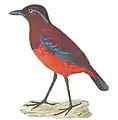Graceful pitta
The graceful pitta (Erythropitta venusta), sometimes alternatively known as the black-crowned pitta (although this term is more regularly applied to E. ussheri), is a species of bird in the family Pittidae. It occurs in Sumatra in Indonesia, where its natural habitat is subtropical or tropical moist montane forests. It is threatened by habitat loss.
| Graceful pitta | |
|---|---|
 | |
| Scientific classification | |
| Domain: | Eukaryota |
| Kingdom: | Animalia |
| Phylum: | Chordata |
| Clade: | Dinosauria |
| Class: | Aves |
| Order: | Passeriformes |
| Family: | Pittidae |
| Genus: | Erythropitta |
| Species: | E. venusta |
| Binomial name | |
| Erythropitta venusta (Müller, S, 1836) | |
| Synonyms | |
| |
Appearance
The Graceful Pitta is a petite bird that measures approximately 18 cm in length. Its black coloring is enhanced with reddish undertones, and the bottom of its wings have vivid blue stripes running down them. The lower breast and abdomen are a dull crimson. The upper chest is dark brown with a purple hue. The legs can appear to be either a purple-blue or a pale blue, and its iris is a dark brown color. The beak of the bird is black. The bird also has an extended tail which has reddish-black hues as well. There is no difference in the appearance of the males and females.[2]
Habitat
The Graceful Pitta is a native of the Indonesian Sumatra's highlands.[3] The Sumatra highlands consist of thick tropical forest with various species of plants, animals, and insects. The Graceful Pitta enjoys this region because it tends to inhabit dense, moist woods with a thick understory of plants. But the habitat of the Graceful Pitta is currently facing an alarming decrease due to deforestation. Deforestation has increased in Indonesia due to the demand for palm oil with Indonesia being the largest producer of it.[4]
Movement
The Graceful pitta flies close to the ground. Primarily in residential levels through the trees.[2]
Call
The Graceful Pita’s call can be described as a high pitched train whistle. It stays at a consistent pitch.[5]
Status
The Graceful Pitta is super rare and is at risk and vulnerable.[3] Although the Graceful Pitta has been legally protected from hunting since 1931, they still have a primary threat of deforestation to its habitat in Indonesia.[2] This causes their population to steadily decrease as more areas become less occupant/available.
Breeding
Only one nesting has been recorded for Graceful Pittas which took place in May. But according to research, breeding can take place from May to July, and possibly as early as from February to October. The birds construct their nests that typically are placed around 60 cm above the ground, using materials such as dead leaves, bamboo leaves, fine roots, degraded fibers, and moss. The graceful pitta typically can produce two to three eggs every breeding cycle. Each of the eggs has a distinctive look with a dull white tone and dark brown and gray lilac spots.[2]
Gallery
 Illustration by Nicolas Hüet
Illustration by Nicolas Hüet_(20269391674)_(cropped).jpg.webp) Adult and immature
Adult and immature
References
- BirdLife International (2016). "Erythropitta venusta". IUCN Red List of Threatened Species. 2016: e.T22698667A93696083. doi:10.2305/IUCN.UK.2016-3.RLTS.T22698667A93696083.en. Retrieved 12 November 2021.
- Erritzoe, Johannes (2020). "Graceful Pitta (Erythropitta venusta), version 1.0". Birds of the World. doi:10.2173/bow.blcpit1.01species_shared.bow.project_name. ISSN 2771-3105.
- "Graceful Pitta".
- "Indonesian Forests & Palm Oil - Greenpeace USA". 2019-10-10. Retrieved 2023-10-19.
- "Graceful Pitta - eBird". ebird.org. Retrieved 2023-10-19.
